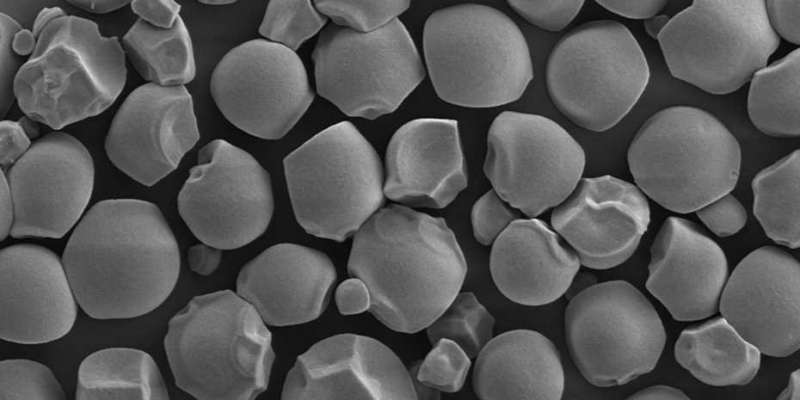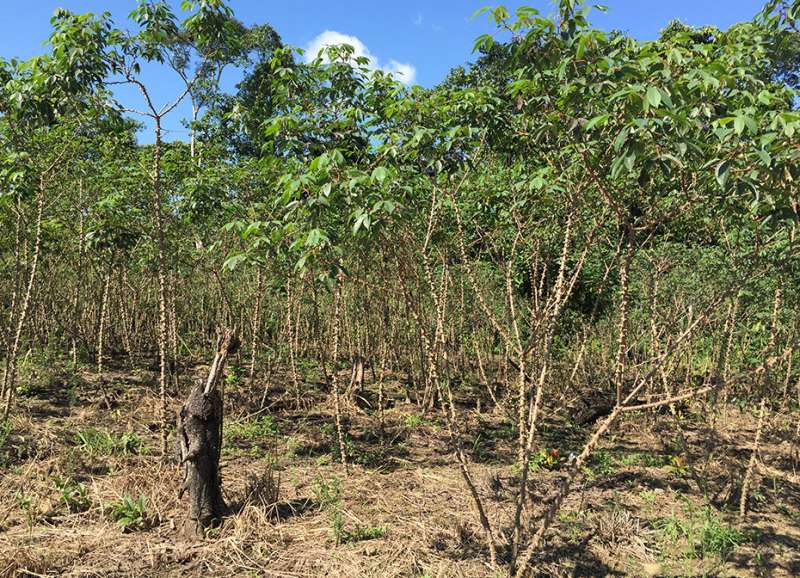Cassava with improved starch

Using the famous CRISPR-Cas9 gene scissors, plant biotechnologists at ETH Zurich have been able to improve cassava. The new variety has amylose-free or 'waxy' starch, which is preferred by industry.
Cassava is one of the world's most important starch crops. The storage roots feed more than 500 million people, and they are also used in many important industrial processes, for instance in paper production or as a food additive. Although cassava plants are hardy and can survive even in drought conditions, it is time-consuming to cross-breed useful new traits into different farmer-preferred varieties. That is why ETH scientist Simon Bull and his team of researchers opted to take a new approach to introduce new traits into cassava. The research teams from Plant Biochemistry and Plant Biotechnology in partnership with Hervé Vanderschuren, a former Cassava group leader at ETH and now at the University of Liège, used the famous CRISPR-Cas9 gene scissors to make changes to the crop plant's genome. Their study has just been published in the journal Science Advances.
They used the gene editing tool to change two cassava genes so that the plant produces modified starch. Starch is composed of amylose (approx. 15 percent) and amylopectin (85 percent). This new modified starch has little or no amylose, and is in high demand on the global market. To achieve this, the researchers inserted a block of several foreign genes into the cassava plants. This block included the genes for the Cas9 protein and for the guide RNA molecule that the CRISPR-Cas9 system needs in order to cut the genetic material at the desired point. It also contained a gene from another plant, the thale cress Arabidopsis, to accelerate flowering.
Gene scissors "silence" genes
The researchers had the Cas9 gene scissors cut the GBSS and PTST genes of the cassava plant at the embryogenic stage, thereby changing the sequence of the plant's genetic code. Both genes are involved in the production of amylose. If they are defective, the cassava plant is no longer able to produce it.
Bull and his research team cultivated several particularly promising plant lines in a glasshouse. The researchers then studied them to determine the amylose content of their storage roots. Some of the lines was found to have produced no amylose at all: the starch in the roots of this modified cassava contained only amylopectin.
These 'waxy' (amylose-free) cassava roots join a list of other globally important crop varieties, such as maize and potato, which have similar traits.
Crossing eliminates foreign DNA
To remove the foreign genetic material they had introduced into the cassava, the plant scientists crossed two individual plants of a transgenic amylose-free cassava line together. Cassava carries two copies of each of its chromosomes; the foreign DNA had been inserted into only one of two identical chromosomes in these individuals. On that basis, one in four of the progeny of this crossing would be free of foreign DNA.
"Without flowers, we would not have been able to perform the cross to remove the foreign material," Bull says. However, the plants retained the ability to produce only amylose-free starch. Bull explains, "This means that in the first generation of progeny, the trait we wanted remained but the foreign DNA could be completely crossed out." The tricky part was getting the cassava to flower and produce seeds. This plant rarely flowers in nature, and almost never in a glasshouse environment. Cassava is generally propagated not through sexual reproduction but rather via stem cuttings, which are genetically identical.

Method saves years of breeding
The method that Bull and his colleagues have developed considerably accelerates cultivation of cassava. "The desired trait, namely that cassava starch should comprise only amylopectin and no amylose, has been achieved using conventional breeding techniques," Bull says, "but it took thousands of plants and several years, rather than just a few plants produced in months as our solution."
In many countries in the Global South, and in particular in African countries, cassava is an important source of carbohydrates. The plant's roots store large quantities of starch that serves as vital source of calories. The roots are also processed for local markets providing income for smallholder farmers.
Industry is particularly interested in amylose-free cassava starch, removal of amylose usually requires more processing and energy-consuming methods for starch purification. Consumers may also prefer the waxy, amylose-free starch. "That's why this new variety of cassava should be very appealing both to consumers and industry alike," Bull says.
More information: Simon E. Bull et al. Accelerated ex situ breeding of GBSS- and PTST1-edited cassava for modified starch, Science Advances (2018). DOI: 10.1126/sciadv.aat6086
Journal information: Science Advances
Provided by ETH Zurich

















